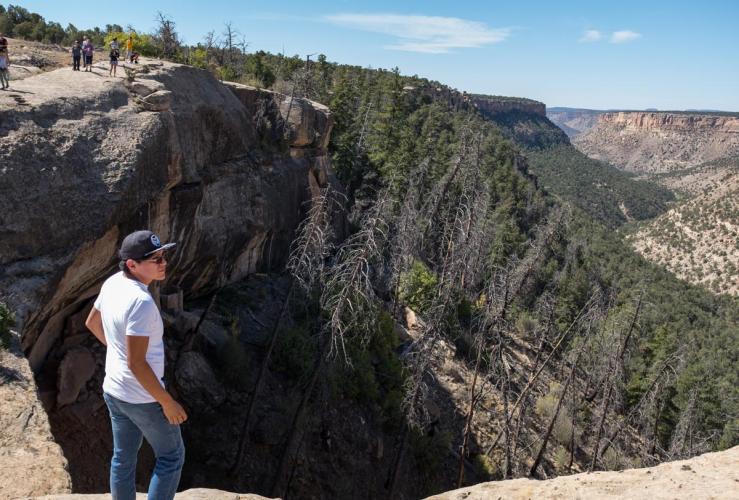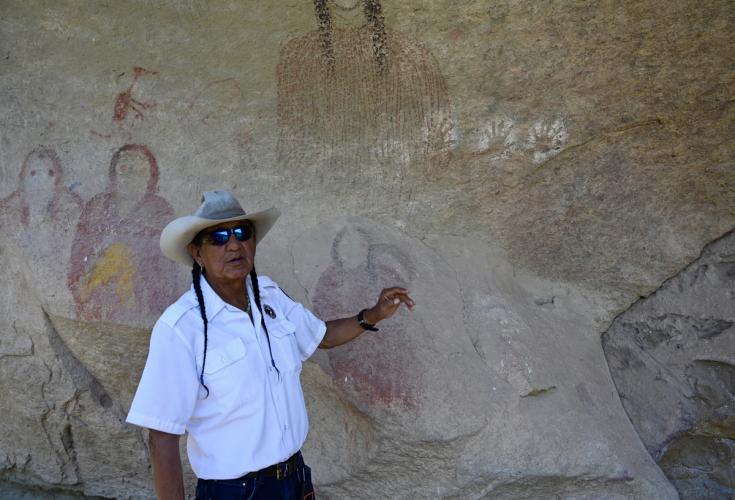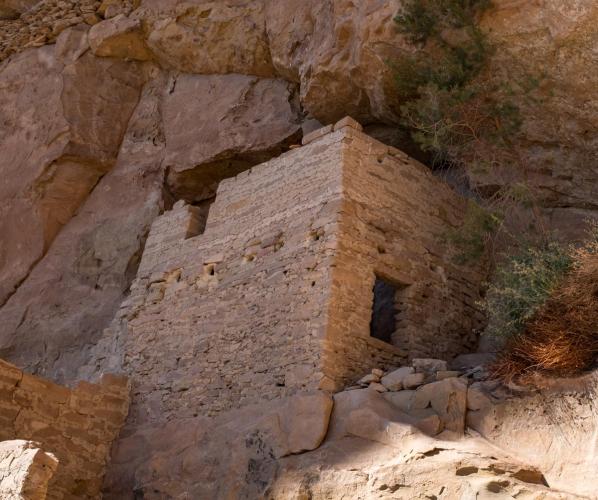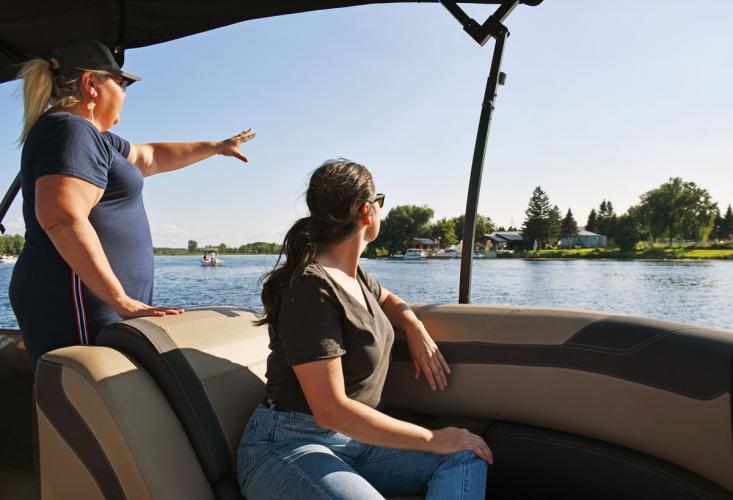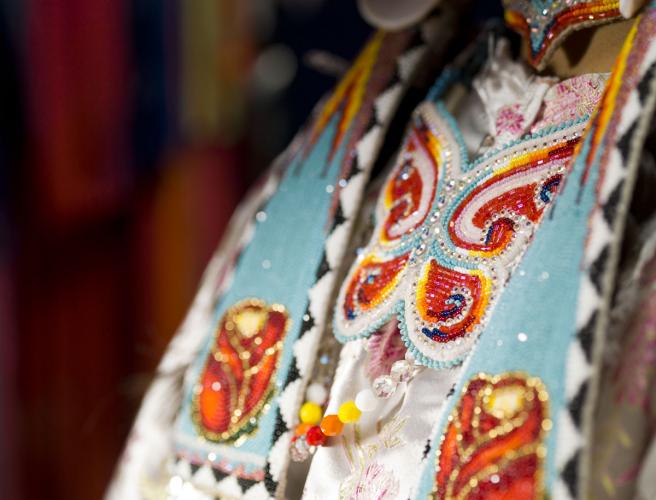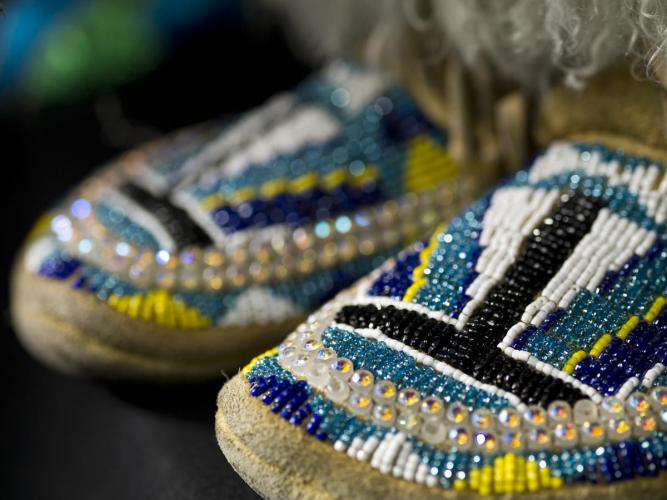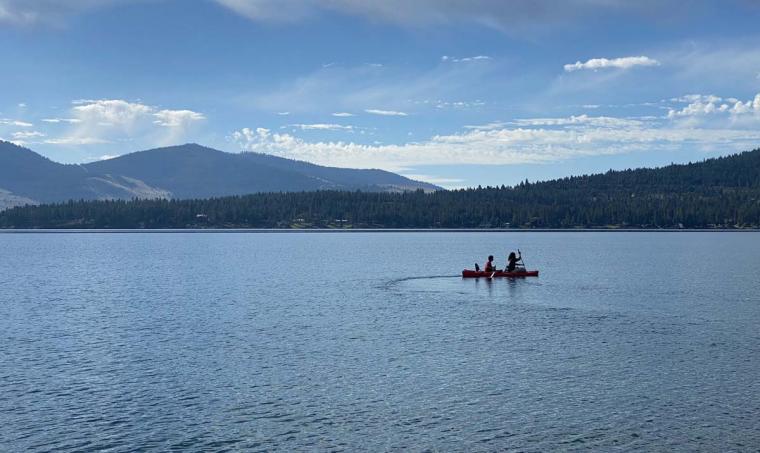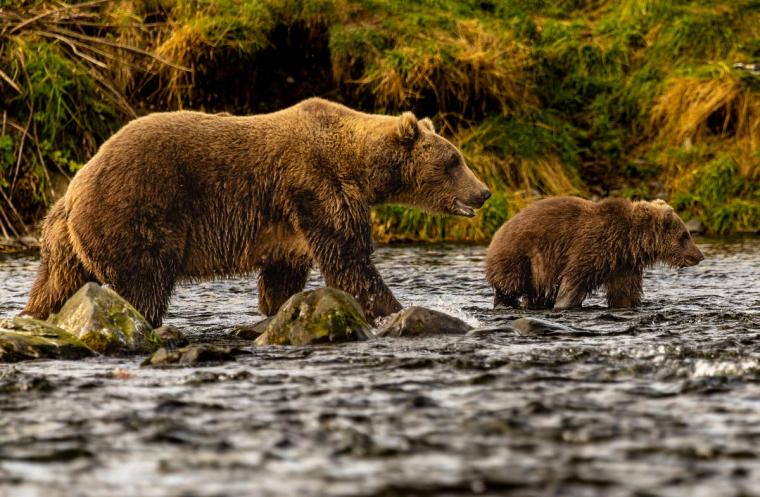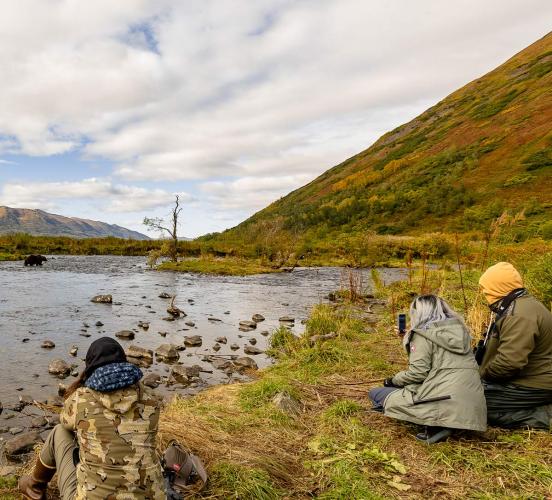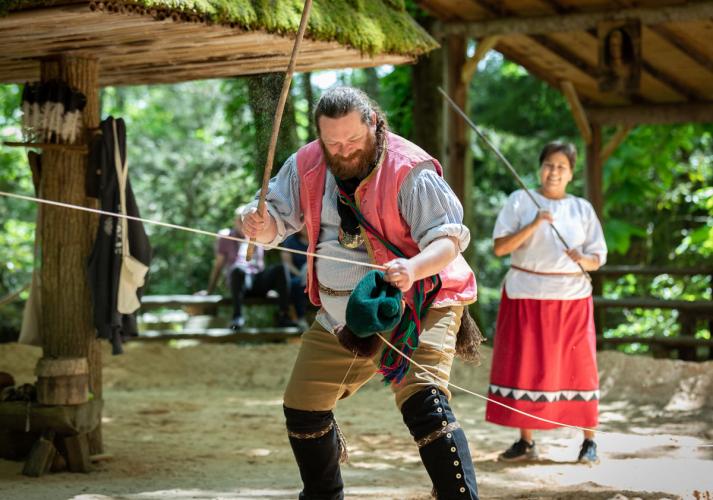The road into the Ute Mountain Tribal Park in southwest Colorado winds along tawny sandstone cliffs and towers before turning into the Mancos River canyon. Wild horses browse scattered grasses below the bluffs. On a morning this past May, eight tourists climbed into a van at the Tribal Park Visitor Center. The driver and tour guide set out, rounding the first corner into the river canyon, when a coyote bolted across the road. The driver stopped and the tribal park tour guide, Rickey Hayes (Ute Mountain Ute), stepped out. He faced the coyote’s path, looking into the morning sun rising over mesas topped in deep green juniper and pinyon woodlands. “It’s like an omen,” the driver explained while Hayes spoke a prayer.
The coyote, meanwhile, paused in the knots of grass and looked back toward the van. Hayes explained that to the Ute, Coyote is a trickster, and if one crosses your path, mayhem soon follows—flat tires, the van catches fire or, more likely, given the recent rain, bogs down in mud. His offering asked the coyote to look the other way.
The tour resumed, heading up the canyon just south of Mesa Verde National Park. It is laced with archaeological sites, including 1,000-year-old dwellings and petroglyph panels that can be visited only in the company of a Ute tribal guide such as Hayes. At the first stop, tourists unloaded along early summer wildflowers, pale orange blossoms scattered among the sagebrush and greasewood.
Before hiking out to the village site, Hayes shared some of the origin stories of how the Ute and Hopi, whose ancestors also lived in this canyon, came to be here in this world. Visitors to the canyon can glimpse signs of that journey and the clans of those who came here. A handprint on a wall offers a gesture across the centuries that said, as Hayes paraphrased, “We were here.” He said, “These cliff dwellings were left here to remind us we’re following in our ancestors’ footsteps.”
By allowing non-Native visitors onto their lands, Indigenous communities have found ways to share their histories, cultures and worldviews. Individual tribal members and tribally run companies host dinners and dances, offer places to watch wildlife, teach about traditional crafts or food customs, lead hikes or boat tours—all while sharing their peoples’ histories on their reservations or former ancestral lands that are now public spaces. Tribal tourism has grown to a $15.7 billion industry, with one in four American Indian, Alaska Native and Native Hawaiian businesses focused on hospitality, according to the American Indian Alaska Native Tourism Association.
Tribes launched the American Indian Alaska Native Tourism Association 26 years ago to promote cultural heritage tourism in Native nations and communities across the United States and to address inequities in the tourism system. Sherry Rupert (Northern Paiute/Washoe), the CEO of this national nonprofit organization based in Albuquerque, New Mexico, said while tourism provides economic benefits, it more importantly offers ways to preserve the cultural identities of Indigenous peoples while giving them a way to tell their own stories. She said, it “provides jobs for our cultural guardians, and further enhances our efforts to preserve our culture, preserve our languages, preserve our sacred spaces and places.”
Chris James, who is president and CEO of the National Center for American Indian Enterprise Development, agreed that if tribes offer visitors managed experiences, they can control what to share and how. “There are some areas in every community where you just don’t want people to go to,” James said. “So, you have a dedicated path, you have areas that are very specific—these are the sites that we welcome tourism.”
His organization has worked since 1969 to support Indigenous entrepreneurs. In 2024, it launched the Native Edge Tourism Technical Assistance Center for tribally owned businesses that wished to open or expand tourism ventures. The goals include helping tribes plan for and manage the challenges that can accompany increased visitation, including nuisances such as littering or trespassing from spillover tourists visiting nearby national parks and preventing damage to protected areas.
Tribes and tourism have a history fraught with frustrations that leaves some tribes reluctant to promote tourism. For centuries, tourists’ search for cultural performances, particularly those that confirm a preconceived and often over-generalized image of Native American culture, has left those communities with the sense that their cultural practices are performative or transactional, said Hunter C. Old Elk (Apsáalooke/Yakama), the interim curator of the Plains Indian Museum at the Buffalo Bill Center of the West in Cody, Wyoming. “There’s a temptation for the tourists to come in and want to see it the way that they imagine it was or has always been, and then there’s pressure on the community to kind of recreate that or continue creating that,” she said. “It kind of freezes the cultural practice.”
Overcrowding, vandalism and looting have also prompted some tribes to limit or avoid allowing tourism altogether. Tribes have also been pressured to share cultural practices or sacred sites that are not for outsiders. Old Elk said, what is important is for tribes to consider “consented visibility,” that how and what tourists explore stems from a place that uplifts Indigenous communities in telling their own stories about both themselves and, through shared stewardship, places of deep meaning.
A Ride Through History
The lands of the Mohawk and other Akwesasne peoples spread over the international boundary between Canada and the United States, divided by the Saint Lawrence River. But the waterway also links the Akwesasne tribes, said Brendan White. Members of the Mohawk Nation, he and his wife, Chessie Thomas-White started Mohawk Journeys about six years ago to build on a family tradition of spending time on the river. On their three-hour boat tours, they discuss tribal history and lifeways from before Europeans arrived, Akwesasne’s unique position in what essentially served as the gateway of the continent for the first colonists and that the Mohawk worked as guides for those first explorers and those who followed. They also share pride in their community, such as in a historic church built in the 1700s on traditional Mohawk ceremonial grounds and a new fire station. And as their small boat slips through narrow side channels, tourists can see nesting eagles.
“It’s a journey back in time. It’s a journey into Mohawk culture. It’s a journey into so many aspects of our life as a border community,” White said.
“Even though all boats can come through here, I’m still taking people to a place they never knew existed because the stories we tell and perspective we have, any other generic tour boat does not have,” Thomas-White added. “It’s not that Akwesasne land is in Ontario or Quebec or New York; New York is in Akwesasne land. That recognition, that they were here first, is growing,” Thomas-White said, “and tourism is a huge part of it.”
The Akwesasne Economic Development Office has gotten involved in tourism also, supporting efforts to add guided medicinal plants walks as well as lacrosse stick making, basket making and beadwork classes. The community has restaurants, a casino and a museum. “It’s really starting to pick up here,” Thomas-White said. “I’m happy for it, too. It’s not just us. Somebody doesn’t just come through, get on my boat, go ride around and leave. … That is revenue and economic energy for Akwesasne.”
During their first summer, their boat tours were booked primarily by community members wanting to get out on the water with their families. Instead of running through her talking points, Thomas said they shared stories. She watched one older man sit silently for hours only to give her “the biggest hug” as he left, having spent that time reliving memories of coming to the river as a boy. “We tell some of their stories now on the water, too,” Thomas-White said.
With tours more often being booked by non-Native visitors, they invite questions from them and spend time dispelling rumors and stigmas about reservations, the ways tribal members live and their culture. She lets them know, gently, that no, people do not live the way they did centuries ago. Water pollution makes people reluctant to eat the fish from the river, for example. She shares how that affects the Mohawk, how they come together in time of need and sadness, and how she hopes the river becomes a place they come together in times of joy.
Preserving Traditions
When staff at the Coeur d’Alene Tribe’s Casino Resort Hotel in Idaho started developing cultural programming a decade ago, they realized some of their traditional skills were all but lost. “So we started it with the tribe, and then we slowly kind of opened it to the community,” said Yvette Matt (Coeur d’Alene), marketing director for the casino. “There is a balance of making sure that we aren’t giving away too much of the sacred part of our culture.”
She initially had not felt comfortable learning traditional skills that would have been taught by elders or parents to their children and grandchildren such as basket weaving, beading or making moccasins or dentalium shell necklaces. However, as the casino started offering these workshops, she started to learn what she had not learned growing up. She began to bring her daughter along, who is now 15 years old. “I wanted her to learn these skills and these traditions that I didn’t really know,” Matt said. “She’s danced her entire life. I never danced until she was born.”
At the casino, non-Native visitors can also enjoy dinners of smoked salmon, huckleberries and fry bread during a mini-powwow that highlights the tribe’s dances and a drumming group. A reenactment tells how Mildred Bailey, a Coeur d’Alene tribal member, became a renowned jazz singer. Through conversations with the tribe’s cultural department and other tribal members, the casino has developed cultural programs with an eye for what is too sensitive to share with visitors. “If you have the tribe behind you as to what you’re doing and why you’re doing it, then it makes it a whole lot easier to share that with the world,” Matt said.
For example, cultural programming staff considered doing a cedar basketmaking workshop, and Matt, her daughter and the cultural programmer went to harvest cedar. Afterward, they decided that part of the process was too sacred to share, so they might show how to make cedar baskets but not how to collect cedar. Matt said, these experiences are really about “educating and making sure that when we do this, it’s to grow acceptance of our culture.”
Healing Campfire Stories
Camp Ka Papa sits on the shores of the massive Flathead Lake in western Montana, part of which is in the Confederated Salish and Kootenai Tribes’ Flathead Indian Reservation near Glacier National Park. Its campsites are spaced out among the pines, with access to a communal fire pit, sandy beach, dock and gazebos for outdoor cooking and dining. Campers can swim or paddle kayaks in the lake and hike trails.
By sharing this place, as a Kootenai tribal member and direct descendant of Kootenai Chiefs Koostatah and Big Knife, Keya Birdsbill (Kootenai) said she is making a dream of her grandmother’s come true.Her Water People Tours guides visitors through Kootenai history, the tribal bison range and other significant parts of the reservation. Kootenai people have been referred to as the Water People, the seven bands of the Ktunaxa Nation historically found around major water bodies, which gave Birdsbill the name for the tour company. “Ka Papa,” a Kootenai word that can reference a grandparent or a grandchild, honors her grandmother’s wish.
When Birdsbill and her husband, Louis Camel (Salish Pondereille), contemplated how to honor that wish, they tempered that desire with an ecological consciousness. They landed on creating a campground for a small number of campers they can educate about Kootenai culture.
“We offer a tapestry of ancient stories that bind us to our aboriginal territories—every mountain, lake and river,” she said. “It is paramount that we tell these stories in our own way, and that we actively work to revitalize and preserve our Kootenai language. This is how we ensure that a small, vibrant band of Kootenai continues to thrive here on the lake, carrying on what our people have done since the beginning of time.”
While her business is independent, Birdsbill said the tribal council has always supported their ideas. She sees the camp’s work as being aligned with the tribe’s mission to foster business ownership among tribal members and protect tribal property and natural resources.
Since opening to guests in 2022, Camp Ka Papa has begun to hire tribal youth, who then spend a summer steeped in and sharing their history and cultural traditions. They even hear and speak some of their Kootenai language, which has lost many of its fluent speakers. When Birdsbill started guiding tours and managing rental cabins as a teenager, she was trained to keep the conversation “positive, no matter what.” She opened Camp Ka Papa with that in mind, including the specifics: Under no condition would they discuss the deeply painful history of boarding schools.
Then, while she was sitting around the firepit with one of their first families to come camp, the Milky Way strung through the sky overhead, one of the family’s teenaged sons asked about boarding schools. Birdsbill talked about her grandmother and her stepfather, both boarding school survivors, and the impact that system had on her family
and community.
“We were all crying because it was sad, but in the end, it was such a beautiful, strong connection,” she said. “So I think sharing our history and hearing it from us, telling it our way, it’s so important, and that’s what people are looking for.”
Generational Renewal from Nature
The Kodiak Brown Bear Center is a lodge on an island in south-central Alaska owned by Koniag, an Alaska Native regional corporation. A quick boat ride away, brown bear mothers and their cubs often congregate in a river filled with salmon.
“Our people have been there for thousands of years, and it is near and dear to our hearts. We want to be good stewards to our land and maintain its protection, but also to share the bears with people,” said Stacey Simmons (Sugpiaq/Alutiiq), director of operations for the center.
In addition, just around the corner from the lodge’s bear-viewing platform are archaeological sites where Simmons has seen pieces of charcoal left behind from 4,000-year-old campfires. Guests come to the island and the Native-owned lodge for the bears, she said, and then have a unique, meaningful experience with people who have a deep relationship to that land. “It is just one of the most magical places you’ll ever be in your life,” Simmons said.
As a teenager, while waitressing in one of the lodges in her village of 300, she learned that sharing her experiences, her community and her land with people helped her fall in love with it. “When you’re sharing it with somebody and they get excited to talk to you about it, you’re like, ‘Wow, that is cool,’” she said.
Revenue generated from the lodge, which opened in 2012, supports Alaska Native corporation programs such as apprenticeships and scholarships for youth. Such scholarships helped Simmons go to college and then graduate school. Recently, the lodge started a youth apprenticeship program to offer training in a range of hospitality skills, from teaching yoga to operating a boat.
Simmons said telling visitors that their money helps support local youth is her favorite part of her job. “It’s like, thank you for being a patron, because it means so much for us,” she said. “You are making a difference in the lives of our youth.”
Building on Past Successes
Tribes across the United States are finding the right amount of tourism in their communities and what aspects of their culture they decide to share, said James. “Some folks really welcome and want to have guests and use that as an economic driver. Other folks are like, you know what, maybe we don’t, and then some tribes are doing it sort of hybrid.”
James’s parents ran restaurants, and his grandmother ran a craft store, so he grew up amid the tourism market and watched it boost businesses in rural western North Carolina. Particularly for small or rural native communities, a new tourism business creating a few jobs can make a big difference, and one successful entrepreneurship can spark others. The Eastern Band of Cherokee Indians in western North Carolina has embraced tourism for the past 50 years with a museum, arts and crafts, and a living village that recreates Cherokee communities of past centuries. Guests meander through traditional summer homes and winter houses and cabins while watching artisans practicing traditional crafts such as finger weaving and beadwork. In an outdoor theater, Cherokee actors perform the play “Unto These Hills” that tells the story of their culture, the Trail of Tears and how the tribe was able to remain in their western North Carolina homelands. The theater opened in 1950 and the village in 1952 in hopes of increasing tourism to the area, said Laura Blythe (Eastern Band of Cherokee), program director for the Cherokee Historical Association. This organization owns and operates the Mountainside Theater and Oconaluftee Indian Village on tribal land held in trust with the federal government. The village and theater employ about 100 tribal members every season.
“To me, it’s beautiful because we are the ones that are participating, living, breathing all of it every day,” Blythe said. “The language, the crafts, the dances, the songs, the prayers—you can find a bit of that at the village at any given day because it’s us, it’s who we are.”
She said the village also dispelled false depictions of the Cherokee culture, although it has many challenges. Like any nonprofit, the historical association running the village and theater can face fundraising shortages with the village open only seven months a year. Appropriation of dances or songs is also a concern, and craft presentations are also adapting to an era when people want to be more immersed and interactive. The 75-year-old script is also being revised to respond to modern audience interests as well as tribal community feedback about what is portrayed and how.
Native nations are also finding their way into bigger travel trends, such as promoting sites in nature with “dark skies” rather than city light pollution and building up agricultural and culinary tourism to include more Indigenous-owned restaurants and food trucks. AIANTA is also working to educate travelers about the difference between a tour company that might include “Native” in its name rather than an actual Indigenous-owned business. The organization is even developing some brand standards and accreditation to help travelers recognize Indigenous-owned businesses, resorts and hotels.
“Right now, we’re kind of disconnected, disjointed, because the tourism industry hasn’t really been set up for our success as Native nations,” Rupert said. Local visitor centers or tourism departments, which often rely on hotel room taxes, often leave Native nations out of marketing efforts in part because even if that tribe runs a hotel, those hotel room taxes likely go back to the tribe rather than the state tourism fund for advertising.
“Oftentimes our Indigenous destinations and experiences are trying to do all of this on their own,” Rupert said. “You could have an amazing experience, an amazing destination, but if nobody knows about it, they’re not going to come.”
In the Ute Mountain Tribal Park, a wall had pictographs of faces, a horse and a horseback rider. Hayes said his relatives painted this artwork, and his uncle’s hogan was nearby. He suspects the scratches over one of the faces came from people angry with his uncle’s choice as chief to open the canyon to visitors in the early 1980s. But Hayes said he has seen some of his people’s perceptions change since he started guiding at the tribal park in 1989.
When he has heard how his people’s history has been told by outsiders at places such as national parks—how they suffered through famines and died young—he just laughs. The Ute, he said, were feared warriors and excellent hunters, and spent winters happily telling stories, eating and making moccasins. They were thriving. A trail switchbacks up to a series of petroglyph panels adorning successive sheer faces of rock down the canyon. Along the path, bits of pottery peek out of the sand. Hayes picks up a pottery shard with fine black lines painted over white. “The only thing I feel from them is their biggest problem that day was running out of paint,” Hayes said.
One tour attendee from the Seattle area said wanting to hear the true stories of the land and its early inhabitants from those people was what drew her to the tribal park. “It’s humbling to come and to hear,” she said. “And the beauty of the place is astounding.”
Along the petroglyph panel, the canyon’s largest, Hayes spends some time with each figure. He has poured out water in offering at every previous site, and now, the bottle is dry. He turns, stands facing the river, visible only as a corridor of green, and the burnished sandstone canyon walls, storm clouds billowing up over them, and starts to sing. It is an offering also, he said—this time a way of saying thank you.

